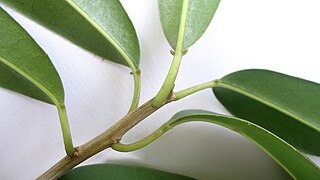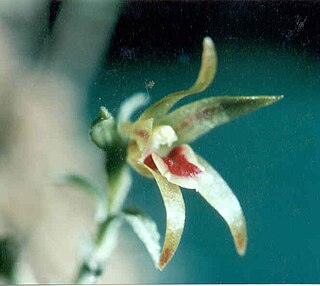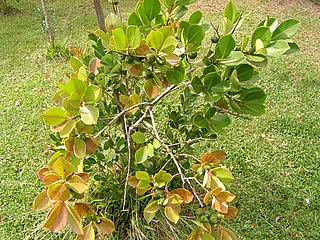
The Republic of Haiti comprises the western three-eighths of the island of Hispaniola, west of the Dominican Republic. Haiti is positioned east of the neighboring island of Cuba, between the Caribbean Sea and the North Atlantic Ocean. Haiti's geographic coordinates are at a longitude of 72° 25′ west and a latitude of 19° 00′ north.

Sapium is a genus of flowering plants in the family Euphorbiaceae. It is widespread across most of Latin America and the West Indies. Many Old World species were formerly included in the genus, but recent authors have redistributed all the Old World species into other genera.

Psidium is a genus of trees and shrubs in the family Myrtaceae. It is native to warmer parts of the Western Hemisphere.

Pic Macaya National Park is one of two national parks of the Republic of Haiti. It is located in the country's southern peninsula, within the Massif de la Hotte. Featuring the country's last stand of virgin cloud forest, it encompasses more than 8,000 hectares. Elevations in the rugged park reach a maximum height of 2,347 meters above sea level at Pic Macaya, the second highest point in Haiti behind Pic la Selle. A majority of the park is composed of two tall peaks: Pic Macaya and Pic Formon.

Plinia is a genus of flowering plants in the myrtle family, Myrtaceae described by Linnaeus in 1753. It is native to Central and South America as well as the West Indies.
South Island telegraph frog is a species of frog in the family Eleutherodactylidae endemic to Hispaniola. It occurs in the Massif de la Hotte and Massif de la Selle, Haiti, and in the Sierra de Baoruco, the Dominican Republic.

The Tiburon Peninsula, or simply "the Tiburon", is a region of Haiti encompassing most of Haiti's southern coast. It starts roughly at the southernmost of the Haiti-Dominican Republic border and extends westward near Cuba, forming a large headland. Three of Haiti's ten departments are located entirely within the region. They are the departments of Grand'Anse, Nippes and Sud. A large part of Ouest department is also located in the region, with the capital, Port-au-Prince serving as the line of demarcation between central Haiti and the south. Half of Sud-Est is also located within the Tiburon Peninsula. The biological hot-spot of the Massif de la Hotte is located in the region in which various endemic species on the island originate.
Catalpa brevipes is a species of small tree in the family Bignoniaceae. It is native to Cuba, the Dominican Republic, and Haiti.

Tomzanonia is a genus of orchids,, consisting of a single species, Tomzanonia filicina endemic to the Massif de la Hotte in Haiti.
The Massif de la Hotte is a mountain range in southwestern Haiti, on the far-western end of the Tiburon Peninsula. The region is relatively remote and is one of the most biologically diverse and significant areas of all of Hispaniola. It also supports some of the last stands of Haiti's dense cloud forest on its peaks. About 2.5 million years ago, the Massif de la Hotte was separated from the rest of the country by a deep, wide sea channel, which resulted in a hotbed of endemism in its bird, plant, and reptile communities.
Ornithidium donaldeedodii is a species of orchids "discovered" in April 2010 when DNA analysis showed that a wrongly labeled orchid at the University of California Botanical Garden in Berkeley, California, was actually a distinct new species. The "new" orchid, which had been mislabeled as Maxillaria croceorubens since the 1990s, was named after orchidologist Donald D. Dod (1912–2008), who collected the specimen in the 1980s in Haiti. The new orchid was officially described in Lankesteriana, an international journal on orchidology, by authors James Ackerman of the University of Puerto Rico and W. Mark Whitten of the Florida Museum of Natural History.

The wildlife of Haiti is important to the country because of its biodiversity. According to the World Conservation Monitoring Centre, Haiti is considered to be "one of the most biologically significant countries of the West Indies". With an estimated 5,600 plant species on the island of Hispaniola, some of which only occur in Haiti, 36% are considered as endemic to the island. A mountainous area country, it is situated in the western three-eighths of Hispaniola and shares a border with the Dominican Republic. There are nine life zones, from low desert to high cloud forests, as well as four mountain ranges, and hundreds of rivers and streams and the coral reefs in the seas that surround the islands. Issues of environmental damage, expanding population, deforesting and erosion are of concern; less than 2% of the original forest remains on account of deforestation. This degradation is traced from the 17th century to 19th century starting with the French colonization of the Haiti and population explosion during the 20th century and for the purpose of forestry and sugar-related industries, degraded the forests. and the environment.
Calyptrogenia is a genus of flowering plants in the family Myrtaceae first described as a genus in 1941. It is native to two islands in the West Indies: Jamaica and Hispaniola.
- Calyptrogenia bifloraAlain - Sierra Prieta in Dominican Republic
- Calyptrogenia bracteosa(Urb.) Burret - Massif de la Hotte in Haiti
- Calyptrogenia cuspidataAlain - southwestern Dominican Republic
- Calyptrogenia ekmanii(Urb.) Burret - Massif de la Hotte in Haiti, northeastern Jamaica
- Calyptrogenia grandifloraBurret - Haiti, Dominican Republic
- Calyptrogenia jeremiensis(Urb. & Ekman) Burret - Massif de la Hotte in Haiti, northwestern Jamaica

Mosiera is a genus of shrubs and small trees in the family Myrtaceae, first described as a genus in 1933. It is native to Mexico, Guatemala, the West Indies, Brazil, and Florida.
Cinnamodendron is a genus of plants in family Canellaceae described as a genus in 1840.
Cinnamodendron angustifolium is a species of flowering plant in the family Canellaceae. It is found growing on the Massif de la Hotte mountain range in southwestern Haiti.
Mecranium revolutum is a rare tree from Haiti, specifically in Sud. It is endemic to the Morne Formon-Pic Macaya region of the Massif de la Hotte mountain range. Along with the other species of Mecranium from the area it is called "macrio", or "bwa pijon" in Haitian Creole.

Rhytidophyllum leucomallon is a species of plant in the family Gesneriaceae, endemic to Hispaniola. According to Liogier it can be found in the Dominican Republic and in Haiti.

Rhytidophyllum auriculatum is a species of plant in the family Gesneriaceae, endemic to Hispaniola. According to Liogier it can be found in Haiti. The flowers are pollinated by bats.
Pleurothallis atrohiata is a is an orchid species, part of the genus Pleurothallis and the Orchidaceae family. It is also known as "The Dark Opening Pleurothallis".










